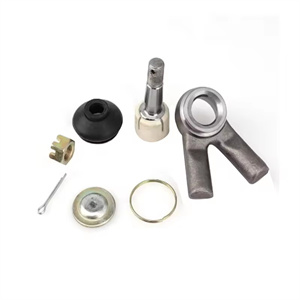The Swing Arm ball joint in a stroller usually refers to a structure similar to a swing arm or rocker arm that connects the stroller wheels and frame, in which the ball joint part can achieve relatively flexible rotation. The main function of this structural design is to allow the wheels to move up and down within a certain range and swing to absorb road bumps, maintain the stability of the stroller, and make the baby more comfortable inside the stroller.
The Swing Arm joints of baby strollers need to have a certain level of strength and durability to withstand various forces and vibrations during use. High quality ball joints can ensure the stability and reliability of the stroller during use.
When choosing a stroller, you can pay attention to the following features related to the Swing Arm ball joint:
Flexibility: The ball joint should be able to rotate flexibly, allowing the stroller to smoothly pass through different road surfaces during the pushing process.
Stability: Ensure the stability of the ball joint structure, without any looseness or abnormal swinging, to ensure the safety of the baby.
Shock absorption effect: A good Swing Arm joint design helps to enhance the shock absorption performance of the stroller and reduce the impact of bumps on the baby.
Material quality: The material of the ball joint should be sturdy and durable, able to withstand long-term use tests.
Ball joints can be produced using CNC machining. CNC machining is a technology that uses CNC machine tools to process materials, and controls the motion and machining process of the machine tool through pre programmed CNC machining languages (such as G code).
In the process of producing Ball Joints using CNC machining, it is first necessary to select suitable CNC machine tools and machining tools based on the design requirements and material characteristics of the product. Then, a 3D model of Ball Joints is drawn using CAD (computer-aided design) software and converted into a format recognized by CAM (computer-aided manufacturing) software. CAM software generates corresponding G-code programs based on CAD models, which contain all the instructions and parameters that the machine tool needs to execute during the machining process.
Next, import the G code program into the CNC machine tool and set the machining parameters and tools of the machine tool. Then, the machine tool will automatically process according to the instructions of the G-code program, including milling, drilling, cutting and other process steps. During the machining process, the control system of the machine tool will monitor the machining status in real time and make adjustments and optimizations as needed to ensure machining accuracy and product quality.
Finally, ball joints processed by CNC machining need to undergo quality inspection and performance testing to ensure they meet design and usage requirements. CNC machining technology has advantages such as high precision, high efficiency, high flexibility, and high degree of automation, which can greatly improve the production efficiency and product quality of Ball Joints.
CNC Machining requires professional technical personnel and advanced equipment support to produce Ball Joints, while also requiring strict control and management of the processing process to ensure machining accuracy and product quality.
